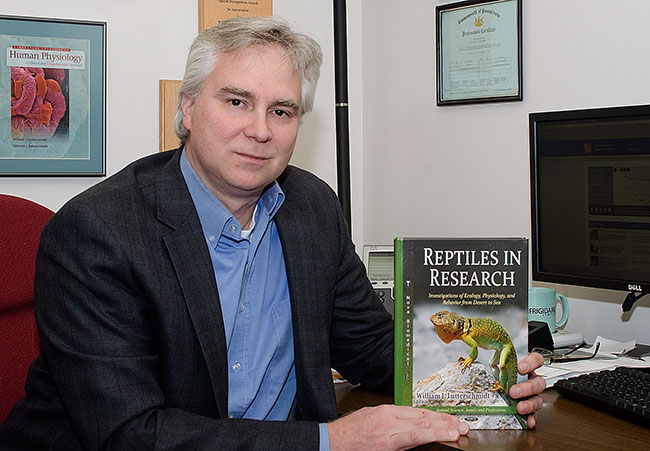Ecologist's Book Gives 'Glimpse Into Passion Of Biologists'
June 23, 2014
SHSU Media Contact: Marissa Nunez
 |
| SHSU ecologist and herpteologist has made a career of studying reptiles and amphibians. His latest book, "Reptiles in Research," presents 24 chapters by more than 24 researchers that show how scientists use reptiles in their academic research, why reptiles offer a unique opportunity to address dozens of interesting and novel questions, and illustrate how environment influences the ecology, physiology and behavior of reptiles. —Photo by Brian Blalock |
Sam Houston State University’s professor of physiological ecology William Lutterschmidt’s passion for reptiles and amphibians began as a child, when he and his brother would spend hours catching salamanders and garter snakes around local parks in his hometown of Allentown, Pennsylvania, located along the Appalachian Mountains.
"I’ve always had a fascination for amphibians and reptiles, specifically snakes, but I never realized you could use them in research and have a career studying them as an academic," Lutterschmidt said.
Until college, that is.
At DeSales University, in Center Valley, Pennsylvania, Lutterschmidt got the opportunity as an undergraduate to work with Howard K. Reinard, studying rattlesnakes on Hawk Mountain in Pennsylvania and in the Pine Barrens of New Jersey.
After graduating with a bachelor’s degree in biology and a state certification in secondary education, he went on to receive his master’s degree in biology from Southeastern Louisiana State University in 1992.
From there he attended the University of Oklahoma and began working on his Ph.D. under the direction of Victor H. Hutchison. One part of his dissertation addressed the temperature tolerance in amphibians, reptiles and fish and how the tolerance for temperature could be influenced by changes in their environmental temperature.
Lutterschmidt received his doctorate in zoology from the University of Oklahoma in 1997 and immediately came to SHSU, where his childhood desire to work with reptiles and amphibians has become fully realized.
Since joining the SHSU biological sciences faculty, Lutterschmdit has published countless research articles, spoken at numerous seminars and symposiums across the country, and has peer reviewed for multiple science journals.
He has authored and co-authored various books, but last year, he was able to turn his passion into an accessible resource for fellow reptile lovers from all academic backgrounds, from students to novice herpetologists, and even seasoned scientists.
"Reptiles in Research: Investigations of Ecology, Physiology, and Behavior from Desert to Sea" makes turtles, lizards and slithering serpents the stars, offering a look at a variety of reptiles and how they are used in a diversity of research programs, from population genetics to life history.
Being Safe Around Summer Snakes |
"These animals are perfect model organisms for my research program in thermal biology because their physiology is influenced by temperature, therefore allowing for interesting experimental manipulations," Lutterschmidt said.
In his first effort as a publication editor, Lutterschmidt wanted to show how scientists use reptiles in their academic research and why reptiles offer a unique opportunity to address dozens of interesting and novel questions by illustrating how environment influences the ecology, physiology and behavior of reptiles. For example, how do web-footed geckos move in desert sands, or how do sea snakes cope physiologically with high volumes of salt in water?
The project, which took just under two years to complete, consists of 24 chapters written by more than 20 authors, with each author specializing in a different area of research but using reptiles and amphibians to help answer novel research questions.
"Some of the contributors were colleagues and some were researchers I never met, but I wanted to cover a diversity of reptilian biology," Lutterschmidt said. "It basically came down to reviewing the literature and figuring out who would be the best scholar to represent a particular area of research."
The goal behind the book is to not just showcase these various fields of research but to highlight it in a more popular context so anyone from academics to the general reader or hobbyist can pick it up.
"Before college I never knew this type of research existed so we hope to showcase some these research programs to everyone," Lutterschmidt said.
The book uses catchy, interesting titles for each chapter like “Town and Country Lizard” by Susanna French, which looks at a new field of research called urban ecology—the study of animals in an urban setting away from their natural habitat.
Other chapters include “Hidden Giants” which discusses the problems associated with studying secretive invasive pythons; “From Marshes to Medicine” looks at the role of immunological defense in the American alligator.
Lutterschmidt also contributed a chapter about the terrestrial activity and seasonal timing of reproduction in the Fully Aquatic Mud Snake called “Crossing Higher Ground.”
"Reptiles in Research" is Lutterschmidt’s first publication as editor, which he said was challenging at times.
"Putting together all of these diverse research interests in one cohesive volume while keeping a central theme was difficult, but I think it all came together as a very informative volume in the end," Lutterschmidt said.
"I hope this book will capture the interests of all readers while providing a glimpse into the passions of scientists who find reptiles fascinating creatures of study," Lutterschmidt said. "Reptiles serve as amazing organismal models that continue to advance our knowledge and understanding of a complex biological world."
- END -
This page maintained by SHSU's Communications Office
Associate Director: Julia May
Manager: Jennifer Gauntt
Located in the 115 Administration Building
Telephone: 936.294.1836; Fax: 936.294.1834
Please send comments, corrections, news tips to Today@Sam.edu.

 SamWeb
SamWeb My Sam
My Sam E-mail
E-mail

